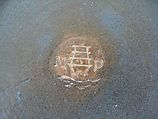Vase
Manufacturer Marblehead Pottery
Marblehead Pottery grew out of a widespread movement that engaged craft enterprises as beneficial to patients suffering from nervous disorders. In 1905 Dr. Henry J. Hall established such a clinic in Marblehead, Massachusetts. The scenic seacoast village of Marblehead, with its tranquility, views of the ocean, and salt air was deemed well suited for Hall’s sanatorium. Jessie Luther, a painter, weaver, and potter from Rhode Island who had experience in teaching therapeutic crafts, supervised the different craft enterprises of textiles, wood, and ceramics. Shortly thereafter, Hall hired Alfred University-trained Arthur E. Baggs to lead the clay-working operations. The idea of a therapeutic workshop for convalescing patients, however, was soon short-lived, and after about a year the pottery became a separate entity. As Hall acknowledged, the technical requirements of running a pottery “proved so exacting that since the first year it has seemed wise to separate this department from the medical plan entirely and to give it full professional swing unhampered by the requirements of teaching.”
The independent pottery that Baggs supervised was modest in size with about six in staff, and it soon established its own artistic personality. As exemplified by this vase, the predominant palette of the pottery was dull greens, blues, and browns, and was likened to the New England seacoast. The designs at Marblehead, provided by Baggs and several skilled patients and local residents, also emphasized local motifs—sea birds, fish, cottage flowers, and even seaweed. Sometimes the maritime theme was emphasized, as in this vase depicting a Roman galley ship, perhaps a nod to the Marblehead mark of an old-fashioned sailing clipper.
Due to rights restrictions, this image cannot be enlarged, viewed at full screen, or downloaded.
This artwork is meant to be viewed from right to left. Scroll left to view more.





